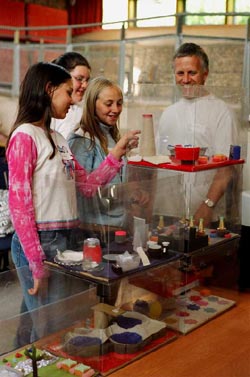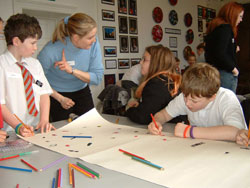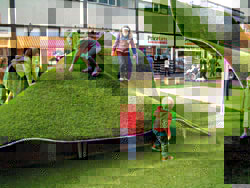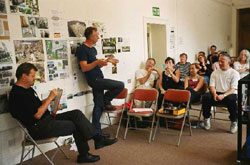People Making Places
Yorkshire Architecture, Art and Built Environment Programme 2002 - 2004
People Making Places is a Yorkshire based programme that combines creativity with realism. The aim is to involve as wide a range of people as possible in a programme that helps to improve regional demand and capacity for high quality urban design. In the two years from 2002 to 2004, over 25 events, seminars, workshops and arts-based street transformations have taken place, involving professionals and non-experts, schoolchildren and councillors, artists, planners, architects and the general public. People Making Places is the work of Public Arts, based in Wakefield.
Below, Robert Powell, Chief Executive of Public Arts, describes how the project came about. Further details of the achievements of the programme are in the publication, People Making Places: Imagination in the Public Realm, (publisher: Public Arts, 2004. ISBN 0-9540748-1-5) and at www.public-arts.co.uk
Extract from: "People Making Places: Imagination in the Public Realm"
People Making Places. The story so far and what next?
Robert Powell, Executive Director, Public Arts.
People Making Places was conceived in the autumn of 2002 in response to the launch of CABE's Regional Funding Programme. CABE (the Commission for Architecture and the Built Environment), had been set up in the wake of Urban Renaissance the 1999 report of the Urban Taskforce Report chaired by Lord Rogers, with the aim of assertively promoting urban design awareness and skills.
Keen to see its agenda spread quickly throughout the country, CABE decided against the model of establishing regional offices. Instead, it would use the loose network of existing architecture centres and encourage the setting up of others. Although the language was of 'architecture centres', the emphasis was clearly on programmes of broadly educational activity aimed at engaging as wide an audience as possible.
As a public art agency with a history of working in the public realm, we felt that Public Arts was well positioned to respond to CABE's invitation. In fact, it confirmed a direction we had already begun to take and was a logical extension of what we had recently been doing.
Public Arts has been engaged in commissioning artists in Yorkshire and further afield since its foundation in 1986. In addition to promoting the role of artists in the public realm, we have a remit to encourage overall awareness of the environment, and engage in education and advocacy. In its first decade the company had focused largely on instigating public art design and production: its learning mission, and the widening of people's understanding of the nature and importance of the public realm as a whole, had been sporadic and under-resourced.

Box Clever (Architecture Week 2003).
The approach behind People Making Places had already been tried and tested through 'TEA' ó the Training, Education, and Advocacy initiative run by Public Arts from 1999-2001. TEA was based on a series of inter-linked programme components ó professional development, collaboration with Higher Education, critical research and debate, diffusion, and community engagement. It still very much had 'public art' and artists at its centre, but by the end of the programme we had begun to engage with a broader set of players ó regeneration professionals, architects, developers ó and with a broader set of issues too. By the end of the initiative, over 2000 people had participated in TEA activities.
For Public Arts , then, People Making Places was simply a new manifestation of the template created for 'TEA' ó the same interlinked components but with a different emphasis on their overall aim and clientele. In 2001 the Arts Council confirmed further seed-funding for our educational work. With this in our pockets, two years of educational programming behind us, with a strong belief in creative approaches influenced by the arts, and with a heritage site as a base, we felt we had a lot to offer to CABE's agenda in Yorkshire.
Of course, we were not alone. Others in Yorkshire and the Humber were also interested in more effectively promoting quality in the public realm. In the very short timescale permitted by the circumstances, we made contact with as many interested parties as we could, and others made contact with us. By application time, a range of partners and stakeholders had been gathered behind People Making Places, including the Royal Institute of British Architects and the Royal Institute of Town Planners, Yorkshire; the Leeds-based group Concourse; the Construction Knowledge Centre (sadly to be short-lived); and Sheffield Hallam University School of Environment and Development. Particularly in its first year of operation, the programme benefited from advice by individuals involved in all of these. Other collaborations have continued to be explored in the periodÖ among them, with Arts & Business, Wakefield Council, and Creative Partnerships.
In the meantime, another imaginative and far larger-scale initiative was getting underway. Yorkshire Forward, the region's development agency brought in Alan Simpson, a Newcastle-based urbanist with Yorkshire roots, to lead the agency's response to the government's Urban White Paper in the region. The concept, unique in Britain, was to establish a Panel of the best urban practitioners in the U.K. and abroad. These would then be drawn down, in combined teams, into selected Yorkshire towns to stimulate and guide 25-30-year visions; these visions would in turn empower local people and inform future public sector investment. The Yorkshire Urban Renaissance Panel held its first formal meeting at The Orangery in January 2002.
By early Spring 2003, we had received an offer of CABE funding and were planning an actual programme. By then the synergy between the Urban Renaissance effort and People Making Places seemed obvious to those most closely involved. People Making Places could potentially provide a creative, regionally based tool to help the urban renaissance in Yorkshire. There followed significant financial support from Yorkshire Forward, which so far has enabled us to do far more with People Making Places than we had imagined possible at the beginning.

Drawing Attractions day.
In February 2002 we gave the programme a formal public launch in a reception at the Orangery attended by Jon Rouse of CABE, Alan Simpson from Yorkshire Forward, and Andy Carver, Chief Executive of Yorkshire Arts. After a period of intensive preparation and research, particularly linked to the first six towns in which the Yorkshire 'urban renaissance' initiative was beginning to unfold, we held our first People Making Places event ó 'Kids Make Buildings', a workshop with pupils from a local Wakefield school. It was June 2002, national Architecture Week, a propitious moment to start delivery.
The remainder of 2002 was busy ó a regional seminar on the involvement of young people in the urban renaissance, the first Orangery Summer School, and temporary 'street transformations' in Barnsley and Scarborough. In 2003, another dimension was added to the initiative. Looking for a way to further develop The Orangery as a base for People Making Places and as a local and regional resource, we accessed financial assistance from the European Regional Development Fund for a capital project called 'Creative Centre for the Built Environment (CCBE) - Phase 1'. This enabled us to undertake extensive expert research and Orangery design work. We commissioned E.C. Harris and David Cark Associates to scope the marketplace and commercial context, and the resources and structures that would be required to make such a concept work. We also commissioned Alsop Architects to design a new building and Orangery extension based on a well- researched understanding of the site and its meaning, and of our spatial needs. The funding also enabled us to significantly augment the People Making Places programme itself as an action-based research tool for the potential capital project.
What does the future hold? Our own plans involve increased programme focus. We set up People Making Places on an experimental basis, trying our hand at a very wide range of activities and audiences. We have tested subject areas; researched formats, timeslots, labels and language; explored the needs and interests of programme stakeholders and of the region and its people. Now, with the growth of parallel initiatives in Hull, Doncaster, Leeds, Scarborough, Grimsby, and elsewhere, and with the development of a Regional Centre of Regeneration Excellence fostered by Yorkshire Forward, we need perhaps to concentrate on fewer aspects of the wide agenda, and do them with perhaps more depth. We need to see what exactly the programme, and the Orangery as a place, can offer that adds a dimension to the work of others. We will do this in consultation with as many interested parties as we have time and resources to engage with, and who are interested in talking to us. But the basic spirit and methodology of People Making Places will remain.

The Green, co-designed by artist Walter Jack and landscape architects Whitelaw Turkington, Bridlington, 2003. People Making Places.
As for the wider picture: despite all the activity and the hundreds of people involved so far, People Making Places ó like most of the architecture centre initiatives in Britain ó remains fragile. The great gusts of public policy, which have recently filled the sails of interest in urban design's regenerative role, are famously fickle. Which will last? Which will vanish into another government's or guru's latest fancy, leaving the small ships and their crews stranded, sailing on verbiage and air instead of on meaningful resources? At a level below policy, but typically above on-the-ground delivery, are the major actual and potential programme funders and sponsors who have missions relevant to the overall endeavour ó in skills and learning, economic and social regeneration, the built environment, culture and creative industries. In general they are beneficent and interested, keen to talk about possibility. But under the pressure of what artist John Newling has called the 'unrelenting audit', and themselves worried about those shifting policy gusts, these sponsors, while paying lip-service to notions of partnership, innovation, and flexibility, in reality are often displaying the tendency to interpret their practice in ever narrower and more restrictive ways.
We are all working now in a palpable dissonance between the cross-disciplinary integration that everyone says they are pursuing ó 'joined-up thinking' ó and a depressing reality of atomisation ó everyone retreating (though as surreptitiously as possible) back into their old, or even newly- forged, silos; everyone so anxious to see their own agendas forwarded (and measured), and so anxious to ensure that not one of their pounds forwards anyone else's agenda.
This 'cherry-picking' from imaginative, ground-breaking, and cross-disciplinary initiatives is deeply worrying, while the continual effort of resisting or accommodating it draws valuable energy from those individuals trying to invent and manage the initiatives. So often, buffeted by these forces, their response is, in turn, to become defensive and self interested, battening down the hatches against exploration and collaboration. To this extent, although power structures shouldn't be forgotten, this environment is not about 'them and us'. We are all, as individuals, both victims and potential perpetrators.
And, of course, so much in this important agenda depends on individuals. This is true both at the level of championship and in the trenches of delivery. In our 2001 seminar Shared Terrain, already referred to, Peter Jenkinson spoke passionately about the unrealistic and dangerous pressures placed on individuals leading major iconic regeneration projects, in his case the New Art Gallery Walsall, and the enormous personal costs involved. Why does our culture demand so much of people trying to make positive change? In the meantime, a despairing colleague in the North West recently told me how the departure of a single individual (high enough up, but not at the top) from a key regeneration agency had undermined three painstaking years of his own work at forging partnerships, understanding, and trust.

Summer School, 2003.
If, in addition to promoting obvious good practice ó you are also trying to push creative thinking and action, then the challenge is doubled. 'Creativity'....now there's a word for our times! Everyone talks about it, but who really understands or values it? Artists and all other dealers in invention know too well the blank stare of incomprehension, the knee-jerk negativity to the surprising and different, and, worse, the | deep-seated resistance that defeats implementation even when the nod has -apparently been given. This is not just about scary artists either : the solitary officer in a local authority or other organisational bureaucracy, trying to push a small bright idea, experiences this too.
The problem is that the public realm agenda requires flexibility ó in fact, it requires creativity, the very commodity that so many seek and speak, so few understand, and so many run away from when it comes near them. People dedicated to the world of public realm delivery tend to fear creativity because they think it is impractical and will cost more. In fact, imagination is all about testing accepted thinking to find a new and more effective practicality... and, faced with the demands of our era, it is lack of creativity that is devastatingly expensive.
In Yorkshire, the Urban Renaissance initiative, will never again unfold in the way it did ó creatively, unexpectedly, barely planned, at high speed ó a surprise attack from an unexpected direction and sponsored by an unlikely host ó nor can it realistically do so. Risk-taking and imagination, as already suggested, must lead to improved practicality and delivery.
How to embed and implement, and achieve wide engagement and support, without losing the creative edge, the energy, the innovation, the quality? This is the challenge now facing all of those concerned about the quality of the public realm in the next phase, from People Making Places, to Urban Renaissance in Yorkshire, to better streets, homes, and public spaces nationwide.
In the end, it's the 'people' referred to in 'People Making Places' who will make or break the endeavour.....individuals in all the corners of the terrain, expert and non-expert, designed and those designed upon, developer and developed. They (we) must first of all care about public space, then take on the impediments to making it better. "The gasp of trust choking drew my eyes from the unrelenting audit" John Newling from the exhibition "Currency and Belief", Yorkshire Sculpture Park, 2002. 'Cross-currents', as mentioned earlier, seems an appropriate theme. Arguably, cross disciplinarity ó a big word for the ability to engage with those coming from different directions than ourselves ó is the key skill shortage facing us at the moment. To fix it, the people trying to deliver programmes need to communicate better and find methods and structures for working together. And those in the funding and sponsoring agencies need to facilitate them. Leadership will need to be displayed, and good practice found and fostered. If that happens, all of this huge agenda will move forward, and initiatives like People Making Places , large and small, will thrive and be able to play their part. On balance, there's room for optimism.

